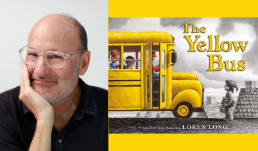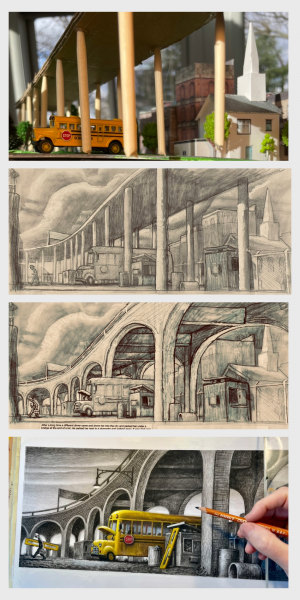- Categories:
Q&A with Loren Long, Author of July/August Kids’ Indie Next List Top Pick “The Yellow Bus”
- By Zoe Perzo
Independent booksellers across the country have chosen The Yellow Bus (Roaring Brook Press) by Loren Long as their top pick for the July/August 2024 Kids’ Indie Next List.

Long's newest title follows a yellow bus as she transports an array of passengers, finding joy and purpose in each act of service.
“A yellow bus drives children to school each day and finds joy in her purpose. Then, she transports senior citizens from one place to another, finding joy there, too. Loren Long’s picture book is full of detail and wonder that will enthrall readers of all ages,” said Cathy Berner of Blue Willow Bookshop in Houston, Texas.
Here, Long discusses The Yellow Bus with Bookselling This Week.
Bookselling This Week: This is one of those valuable books that’s going to resonate with kids AND adults. It struck me as a healthier Giving Tree with themes of finding purpose and joy in unexpected circumstances. Did you have that goal in mind as you worked on it? Or, how different is the final product from the initial inspiration?
Loren Long: I did not have that as a goal in mind from the beginning.
I came across this bus. A broken-down bus at the lowest point in her life…sinking in the mud in the corner of a goat paddock, of all things. How did it get there?
I was musing over that for eight months of running by it daily. I started thinking maybe there's a story there. But one day as I ran by, the goats were climbing in and out. And I thought, “that down and out bus seems happy.” So that little thing made me really ask myself. “Why? Why do you think that bus seems happy?” That’s cracking into something about life's purpose and the passage of time and the feeling we get as humans from doing something for others.
I started writing the story and it felt like a contemplative sort of exploration of this bus’ life journey.
It's a little Giving Tree-esque, but maybe a little more hopeful. Or, I also thought of Virginia Lee Burton's The Little House.
The Yellow Bus definitely started out as just a simple story about a yellow bus and morphed into something more soulful and meaningful.
And just a little follow up to that. After I finished the book, I finally approached the owner of the paddock. I found out that it was a goat rescue.
And when I first started running by, the bus’ door was open. At some point he closed it. He told me the floorboard of the bus was rusting out and he was afraid a goat was going to fall through and hurt itself. So even as I was making this book, the bus kept aging…
BTW: Okay, so now we've got to talk about your art and the model town you built for this book. I loved looking at the behind-the-scenes photos, I love that I can see it in the background. So it seems like this was a little bit different than what you usually do. What did your creative process look like?
LL: For this book, it's such a study on the passage of time. And I thought, in terms of time, this would take place over as much as 60 years.
When they first open the book, I want these little eyes (and older eyes!) to see the entire setting of the book — a panoramic shot of where the bus starts up in the little town, and the little valley, across the bridge, along the rolling hills, into a lower farm next to a river. I want the readers to see this and see how that changes in stages throughout the book.
So I did this initial sketch, trying to figure out this little town. And the weird thing is, I had no idea I was going to build a model until I did this drawing.
I’m thinking to myself, “Okay, this was fun to draw, but I did this out of my head, I was just making it up.”
But what if I want to go overhead and see an accurate bird's eye view of this? Or what does this town look like if you're standing on this road looking up at the house?
And for the first time in my career, I decided it would be really beneficial for me to build this little model.

And I'm thinking, “I'm on a deadline. But I can spare 7–10 days to build this little model. And I'll do it on a card table. And I can just use floral foam, and cardboard, Styrofoam, things around the house, etc.”
It ended up not being 7–10 days. It ended up being two months. And it ended up not being a little card table. It ended up being a card table and a six-foot table. It takes up 10 feet by 4 feet of the studio.
I had this little toy bus that belonged to one of my sons. And it was about the right scale, so I built the model based on this little bus.
I was having so much fun. I felt like I was in junior high art class. But at some point, I was like, “I gotta start making this art. I can't keep building.”
But with the model, I could stand up on a ladder and get an overhead view. I have a lamp that became the sun. Sometimes I would stand and draw with pen and paper. And then sometimes I would take pictures, and work from the photographs.
This model helped me draw the whole dummy of the book. And as I sat here at this desk, and it occurred to me it's the yellow bus. It's potentially one of the more iconic symbols in our society. It just hit me: I should do this book in charcoal, black and white, and then paint the yellow bus. So little readers — say 15 months old — can look at this spread, and they may not understand the whole story, but they can find that yellow bus.
I made up some rules like: everything that's touching the bus that's filling her with joy will also be in color.
And there was another thing that was new for me: an X-Acto blade. I would lay down the charcoal, and anywhere I wanted to pop highlights, I would scratch it off. If you look closely in the book, you can see the tiny scratches in the chain link fences, on the raccoon’s face, and even in the sky.
This ended up being a slightly scary endeavor, I was doing a few things very differently. But it was also invigorating. It became a really fun and fulfilling project.
BTW: I'm glad to hear that. And I feel like all the work that went into it really shows. It sounds like there's more freedom, but also more pressure when you're doing the writing and the illustrating versus illustrating for another author. Is it very different?
LL: It's very different, but I think there are some built in benefits that may be hard to define. When I was writing this story, there were things I knew that I could do as the illustrator. But at the same time, I approach illustrating my own manuscript like I would approach illustrating someone else's.
So I think knowing I’m going to illustrate it affects the writing part, more than the writing affects the illustrating part if, if that makes sense.
BTW: It does. Thank you. So can I ask what will you be working on next?
LL: I have another story I'm trying to write. I am much more comfortable illustrating but I think I might be turning into a writer. I'm writing a lot of things, and they're not all good. So that feels authentic.
The next book I'll publish is called Home. It's written by Matt de la Peña, and it is a something of a companion book to Love, which came out in 2018. That will publish in 2025.
BTW: We'll look forward to it. For our last question we like to bring it back around to indie bookstores. So could you talk a little bit about the role of books and indie bookstores in your life?
LL: One of the biggest joys for me, in my long career of publishing twenty-something books, has been meeting the independent booksellers. It doesn't matter if you're in Houston, or Wichita, or Mobile, or Nashville, or Miami, or Portland — you get the point — If there's an independent bookstore, there's a cool community, because the independent bookstores serve those communities.
I have one called The Bookshelf near my house here in Cincinnati, Ohio. They're the hardest working bunch of booksellers ever, and they befriended me after I did a new version of The Little Engine That Could back in 2005.
And when anybody wants to buy a Loren Long book, they will say, “If you want it signed, I'll put it in his orange mailbox at the top of his driveway. I'll text him and within 24 hours, it will reappear in the orange mailbox signed and personalized.”
The support I've gotten from indie booksellers is kind of unprecedented and it embodies the spirit of the yellow bus. It fills her with joy when she is serving others. And I feel like independent booksellers do that same thing. They get joy when they put a book into a customer's hand.

